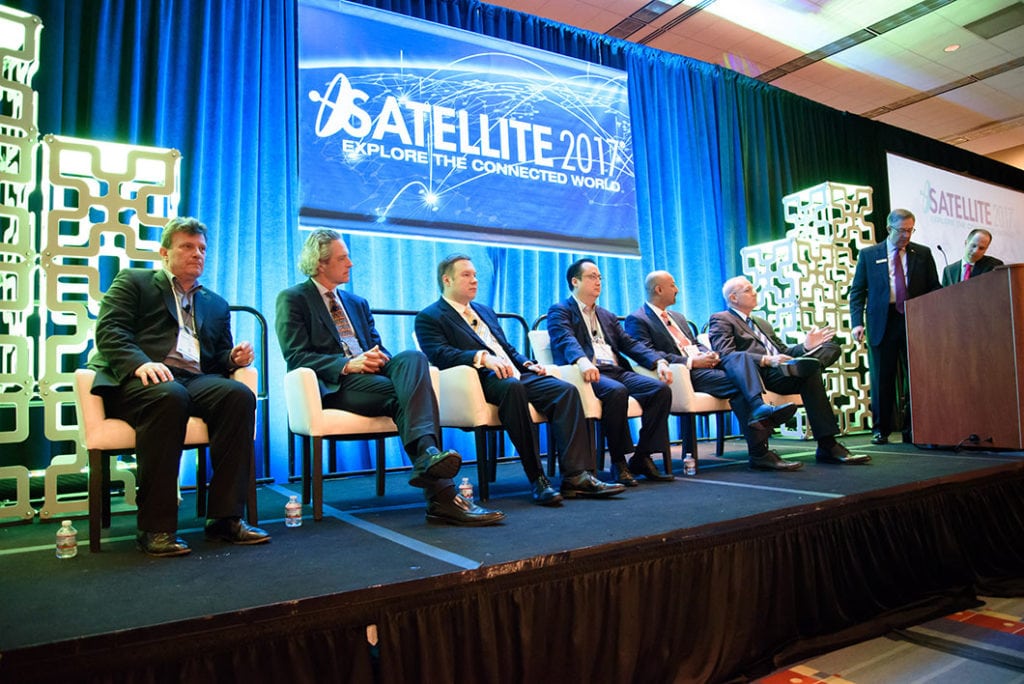Final Panel at SATELLITE 2017 Raises Familiar Issues

L-R: David Harrower, iDirect; Vern Smith, Lockheed Martin Space Systems; Andrey Kirillovich, RSCC; Tom Choi, ABS; Kalpak Gude, Dynamic Spectrum Alliance; Jean-Yves Le Gall, CNES.
ABS CEO Tom Choi has garnered a reputation for speaking unabashedly — so his somewhat harsh comments on the viability of Low Earth Orbit (LEO) constellations came as no surprise during the SATELLITE 2017 Exhibition & Conference. During the conference’s final panel, “Visions of the Future Satellite Industry: Business Beyond SATELLITE 2017,” Choi reiterated his doubts about the goals some companies in the satellite industry are pushing to achieve.
According to Choi, companies rushing to build bigger High-Throughput Satellites (HTS) and launch mega-constellations into LEO are suffering from a “herd mentality … without really understanding how this capacity is going to get sold or where the customers are going to come from.”
“I always try to think about the number one thing: the customer. Who is the customer, how am I going to serve that customer, what technologies do I use to solve a customer problem? I just don’t understand why some of the networks are being designed the way they are,” Choi said, calling out OneWeb specifically as he had in previous panels that week. “You’ve heard me being vocally critical of OneWeb. If I was building a system to serve people, I would put maximum capacity over where those people are.”
While Choi believes all satellite operators have the same end-goal of bridging the “digital divide,” he thinks solving the issue will require innovation that extends beyond just providing global capacity, due to the different connectivity needs of different markets. One major hurdle, he says, is bringing down the cost of ground infrastructure.
As vice president of business development for iDirect, David Harrower is intimately aware of the limitations of ground networks, and agreed with Choi’s point. “What a lot of operators don’t anticipate is the ground network required. It’s a cost impact that is challenging for a lot of satellite operators,” he said. In order to make progress in the industry, Harrower thinks executives need to focus on improving the availability of low-cost terminals, as well as pushing for adoption of emerging technology such as Flat Panel Antennas (FPAs).
Unfortunately, the technology on the ground side simply isn’t evolving fast enough for the satellite industry to steal market share from terrestrial wireless competition, says Andrey Kirillovich, director for integration services and turnkey projects at Russian Satellite Communications Company (RSCC). “The ground segment is developing behind the development of the space segment. The main problem is the readiness of FPAs,” he said. FPAs such as Kymeta’s mTenna product line are only just now becoming commercially available, and the panelists agreed that such products will be key to the industry’s future growth.
“I think we have to look at antennas not as a commodity but as an enablement aspect,” said Harrower. “[They have] to be cheap, easy to install, and readily accessible. We would anticipate in the next two to three years you’re going to see terminals in the $100 range in the consumer market. The costs have to be there to enable machine-to-machine, Internet of Things (IoT), [and] connected cars.”
Still, Choi expressed doubt, arguing that providing connectivity via Geosynchronous Earth Orbit (GEO) will almost always be more profitable. “These phased array terminals are not going to go down to $20 or $30. I could go to a factory in Taiwan today and buy a VSAT antenna for operating in Ka-band for $60. That’s extremely affordable,” he said.
Consequently, according to Choi, ABS will continue to pursue GEO solutions to provide capacity to rural areas. “Our plans are to selectively target specific countries from GEO where we can bring a lot of capacity on a low cost basis,” he said. He highlighted Sub-Saharan Africa, Southeast Asia and the Democratic Republic of Congo (DRC) as areas where ABS plans to target. “Their access to infrastructure is very low and we believe that’s where a low cost GEO service for residential broadband would be the most attractive. The DRC alone is probably almost 80 million people,” he said.
Jean-Yves Le Gall, president of the Centre National d’Etudes Spatiales (CNES), the French space agency, had one warning for companies solely interested in LEO: watch out for orbital debris. Because smaller satellites are more difficult to track and many lack deorbiting capabilities outside of atmospheric drag, Le Gall said the onus is on these companies to ensure their mega-constellations do not become space junk at the end of their lives.
“Governments that allow these systems to launch better take responsibility if these things break or the LEO arc is going to become a death zone,” Choi added.
As for the industry beyond the eternal LEO versus GEO debate, Vern Smith, vice president of communication satellites and new ventures at Lockheed Martin, said he believes the next big wave of innovation will emerge on the production side. He pointed out that historically, satellite manufacturers have built satellites custom to order depending on the client’s specific needs. In the future, he expects to see more standardization as manufacturers “productize things across multiple solutions,” using “common bus platforms across four or five solutions,” he said. In turn, this will significantly shorten the manufacturing process. “Five years out, I would argue that you could see production times on the order of six months,” Smith said.